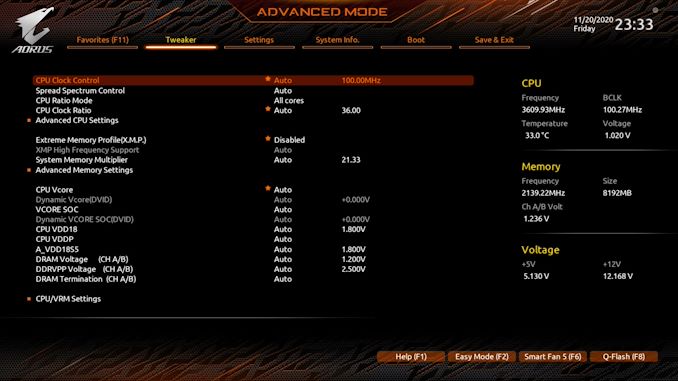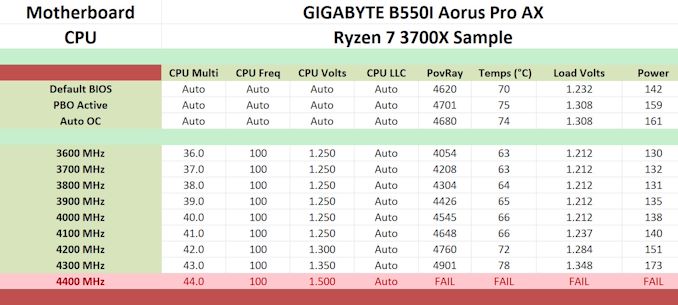The GIGABYTE B550I Aorus Pro AX Motherboard Review: All The Small Things
by Gavin Bonshor on December 7, 2020 10:00 AM ESTOverclocking Ryzen 3000
Experience with the GIGABYTE B550I Aorus Pro AX
When it comes to overclocking AMD's Ryzen 3000, pushing them to even modest all-core frequencies can mean they run very hot. Even with the most recent Zen 3 based Ryzen 5000 processors, Robert Hallock, who is AMD's Director of Technical Marketing, stated in response to a Redditor that they (Ryzen 5000) could quickly hit up to 95 degrees Celsius under full-load. According to Robert Hallock, this is a part of the design and should allow the Ryzen 5000 series chips to boost longer due to the higher temperature threshold, thus giving better performance all across the board. It is recommended that users looking to overclock Ryzen 3000, or even contemplate using the Ryzen 5000 series, do invest in adequate CPU cooling with premium AIO closed-loop coolers looking like the most strong candidates outside of the expensive custom liquid solutions on the market.
Focusing on our experience with the GIGABYTE B550I Aorus Pro AX, the firmware itself is user friendly and responsive as far as a BIOS goes. All of the relevant overclocking settings can be found within the Tweaker section, with options to overclock the CPU, iGPU, and memory all found here. Users can use the CPU ratio mode to make adjustments to the core clock speed, while fine tweaking can be done via the base clock under the CPU Clock Control option. For voltages, the CPU VCore is the most prominent option for pushing more juice to the CPU, while options to change the level of Load-Line Calibration of the 8-phase power delivery can be found under the CPU/VRM settings.
Memory overclocking can be done multiple ways, with X.M.P 2.0 profiles available by enabling the profile on compatible memory for ease of use. Other options for tuning the memory manually with the System Memory multiplier, altering the DRAM voltage, and a section dedicated to tweaking the memory timings. As we've previously noted in previous AM4 reviews, AMD recommends a maximum FCLK (Infinity Fabric Clock) to within 2:1 of the memory frequency, with the sweet spot sitting at DDR4-3600 with an FCLK of 1800 MHz.
Overclocking Methodology
Our standard overclocking methodology is as follows. We select the automatic overclock options and test for stability with POV-Ray and OCCT to simulate high-end workloads. These stability tests aim to catch any immediate causes for memory or CPU errors.
For manual overclocks, based on the information gathered from the previous testing, start off at a nominal voltage and CPU multiplier, and the multiplier is increased until the stability tests are failed. The CPU voltage is increased gradually until the stability tests are passed. The process is repeated until the motherboard reduces the multiplier automatically (due to safety protocol) or the CPU temperature reaches a stupidly high level (105ºC+). Our testbed is not in a case, which should push overclocks higher with fresher (cooler) air.
We overclock with the Ryzen 7 3700X for consistency with our previous overclocking tests.
Overclocking Results
Equipped with a solid 8-phase power delivery, the mini-ITX GIGABYTE performs pretty competitively in our overclocking tests. Not only is the B550I Aorus Pro AX more than capable of pushing a Ryzen 3000 beyond its limits comfortably, but it behaves very well in regards to VDroop in our manual testing. Our AM4 testing with the Ryzen 7 3700X stretches starts from 3.6 GHz and goes as far as we can in the headroom. Although our Ryzen 7 3700X, unfortunately, cannot do 4.4 GHz fully stable, 4.3 GHz is still a good overclock all-cores.
Our POV-Ray benchmark performance increased as we tested each frequency from 3.6 GHz to 4.3 GHz, with solid levels of VDroop control when comparing load CPU VCore to the values set within the BIOS. Naturally, as we increased the frequency, we saw higher temperatures a full load, but not as much when we upped the CPU VCore from 1.25 V to 1.30 and beyond. Power also crept up as we increased the frequency and CPU VCore, which is expected as more juice means more power from the wall.












76 Comments
View All Comments
Gigaplex - Wednesday, December 9, 2020 - link
I'm not sure how that would be a B550 issue, as the Bluetooth module is an add-in card.Questor - Wednesday, December 9, 2020 - link
"The end decision could come down to performance, memory compatibility, and other aspects such as power delivery, rear panel I/O connectivity, which all three models include respectable offerings..."Not so much. There is only so much one can expect (as the article states) with mini-ITX boards. The one thing they had to do? A USB C front panel header. They failed. H
Had this board in cart and was about to hit the, "send it to me yesterday" button when something made me pause. A quick doublecheck and sure enough, no front panel USB C connection. Less bling and more substance please. Fan headers and accessory connections = good. Flashing lights = police stop. No thanks.
jeremyshaw - Wednesday, December 9, 2020 - link
Yeah, every B550 ITX board has one problem or another. MSI has their custom backplate. ASRock has never heard of SPDIF and are allergic to including enough USB ports on their AMD boards. ASUS has serious hate for USB ports (4 USB-A!?) along with nixing the SPDIF port. Gigabyte still pretends USB-C headers are an exclusive Intel feature.Most of these problems magically disappear when these vendors make Intel ITX boards.
Questor - Thursday, December 10, 2020 - link
Amazing how that just magically happens.I was reminded by another here there are USB A to C connectors one can buy. So that is less of a deal breaker to me now. It still depends on the position of the USB A connection since it was not purposely placed as a front connection. Cable length matters.
mkarwin - Tuesday, December 15, 2020 - link
Or when they do AMD ATX ones ;)Silver5urfer - Thursday, December 10, 2020 - link
AT even 6900XT Is out Where are your Architecture reviews ? FFS. We got that stupid M1 BGA trash review deep dive and saying x86 is fucking dead. But where are the reviews of the Nvidia and AMD graphics cards this time AMD got Nvidia in Raster technology but we need the technical details.Really horrible.
Gigaplex - Thursday, December 10, 2020 - link
Calling the M1 "trash" is flat out fanboy bias. It's an interesting chip and performs well. AnandTech covers all areas of tech, not just gaming on Windows.Silver5urfer - Thursday, December 10, 2020 - link
BGA Trash son. Its called BGA trash for a reason, if you love soldered HW enjoy that irreparable garbage, and forget even upgrading RAM, SSD, everything soldered and gated by "custom blackbox security chip". M1 is first product on the translation and ARM based Mac it is garbage and will be garbage, so unless they can catch up and beat Intel and AMD at SMT it's of no use.AT HW is majority for Linux and Windows. Macs ? Do AT review macbooks ? Nope. This is their first. Because of that obsession of showing Apple in glowing light.
10% marketshare product is Mac OS, same sales value for Apple as well, so yeah trash.
Gigaplex - Thursday, December 10, 2020 - link
Pretty much every single Intel laptop is soldered on, too. The M1 architecture doesn't mandate BGA soldering. It's the portable form factor that does. You can't call the architecture garbage just because of a form factor you're not interested in.And yes, AT does feature Apple products. There's plenty of Macbook articles and reviews. Now you're just being ignorant. There's a whole section for Apple.
https://www.anandtech.com/tag/apple
Avalon - Friday, December 11, 2020 - link
I've got the non-ITX version of this board, and it's fantastic.